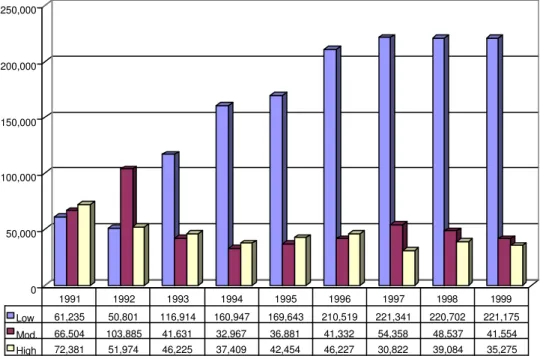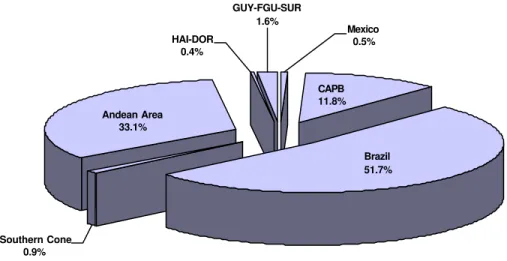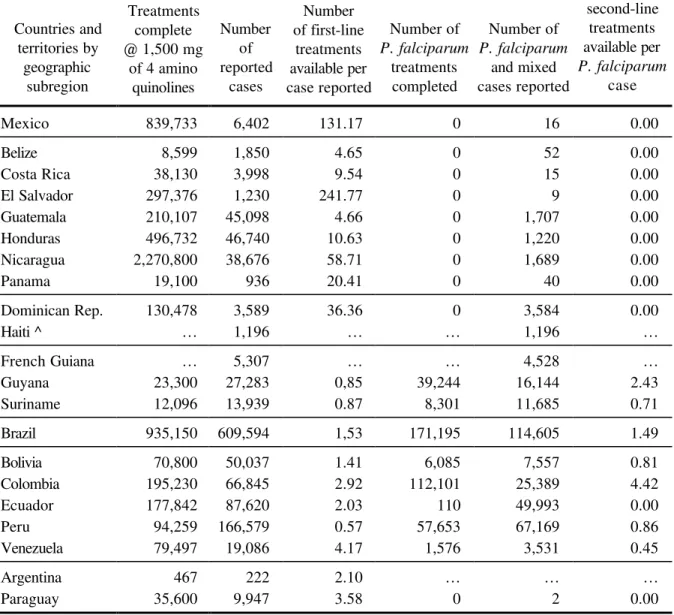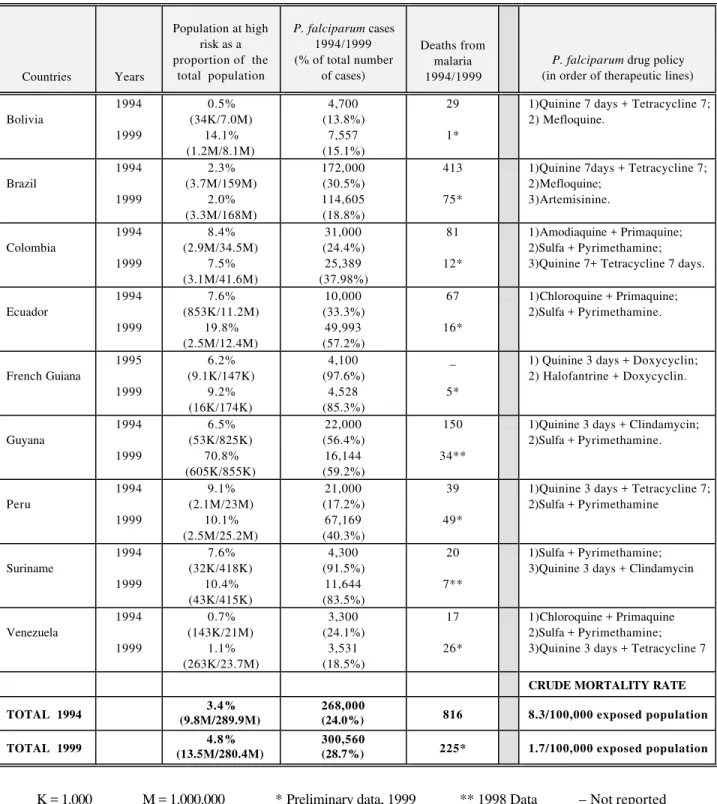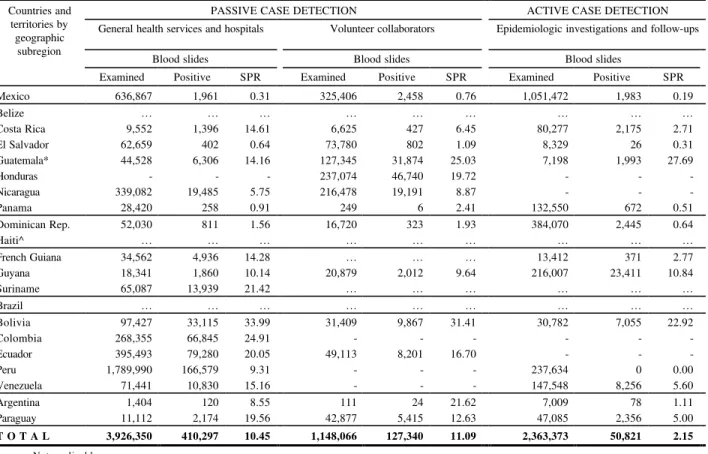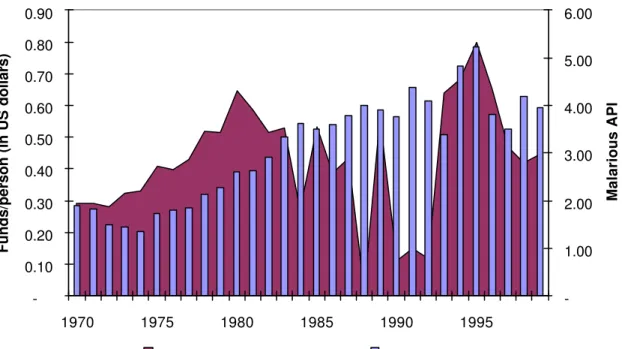42nd DIRECTING COUNCIL
52nd SESSION OF THE REGIONAL COMMITTEE
Washington, D.C., 25-29 September 2000
Provisional Agenda Item 4.12 CD42/16 (Eng.)
17 August 2000
ORIGINAL: ENGLISH
MALARIA
Of the 39 Member States of PAHO, 21 have malaria transmission. In these countries, 77 million people live in areas of moderate and high risk malaria transmission, producing approximately l.2 million cases per year. Since 1992 these countries have adopted the Global Malaria Control Strategy, though with some limits to its complete implementation. The Roll Back Malaria initiative aims at the creation of a movement at the global, regional, national, and local levels to further strengthen the implementation of the Global Malaria Control Strategy.
Roll Back Malaria encourages the use of evidence-based strategies, community-level action, and effective joint action between governments and national and international development agencies. It recognizes that sustained success in rolling back malaria inevitably calls for development of the health sector, so that it can better address a range of priority health problems. It seeks to mainstream efforts to roll back malaria throughout the range of community-level health activities already being carried out by societies at risk of malaria. The initiative is expected to evolve into a social movement on a global scale and to engage local communities that are not yet rolling malaria back.
The Roll Back Malaria initiative is based on the acknowledgement that malaria control must be an integral function of an effective health system with a strong community involvement. Vector control must be part of it through the application of cost-effective and site-specific targeted methods. The utilization of a combination of methods is aimed at reducing the total reliance on residual insecticides over the next few years.
CONTENTS
Page
1. Current Malaria Situation...3
2. Current Malaria Control Strategy Situation...8
3. Major Problems and Constraints...10
4. The Roll Back Malaria Initiative ...11
5. Conclusions...13
1. Current Malaria Situation
In 1999, there were 818 million people living in the Region of the Americas. Of these, 299 million, in 21 countries, were living in areas where ecological conditions were propitious for the transmission of malaria. However, of these, 222 million are exposed to low or extremely low risk of malaria transmission. The remaining 77 million people live in areas with moderate and high risk of transmission (Figure 1).
Figure 1: Population Living in Malaria Endemic-Areas According to Transmission Level, 1991-1999
The API (Annual Parasite Index) in the Region ranges from a low of 0.18/1,000 in Mexico to 309.8/1,000 in Suriname. An analysis by subregion indicates that Brazil reported the greatest absolute number of malaria cases (51.7%), followed by the countries of the Andean subregion, which accounted for 33.1% of all cases (Figure 2).
0 50,000 100,000 150,000 200,000 250,000
Low 61,235 50,801 116,914 160,947 169,643 210,519 221,341 220,702 221,175
Mod. 66,504 103,885 41,631 32,967 36,881 41,332 54,358 48,537 41,554
High 72,381 51,974 46,225 37,409 42,454 46,227 30,822 39,084 35,275
However, the greatest risk of transmission was registered in the subregion that includes areas of French Guiana, Guyana, and Suriname (API = 127.5/1,000), followed by parts of Brazil (API = 118.8/1,000), as shown on Figure 3.
Figure 2: Distribution of Malaria Cases in the American Region, 1999
Figure 3: Annual Parasitic Indices (API)* by Geographic Subregion, 1994, 1999
Brazil 51.7% Andean Area
33.1%
Southern Cone 0.9%
CAPB 11.8% GUY-FGU-SUR
1.6% HAI-DOR
0.4%
Mexico 0.5%
HAI-DOR = Haiti, Dominican Republic CAPB = Central America, Panama, Belize GUY-FGU-SUR = Guyana, French Guiana, Suriname ANDEAN AREA = Bolivia, Colombia, Ecuador, Peru, Venezuela SOUTHERN CONE = Argentina, Paraguay
* Preliminary information for Haiti
0 5 0 1 0 0 1 5 0 2 0 0 2 5 0 3 0 0 3 5 0
API
G U Y , F G U , S U R
The epidemiological distribution of malaria in the Americas has changed due to a decrease in the prevalence of Plasmodium falciparum malaria in the Brazilian Amazon. This decrease is tied to an improvement in case management by means of early diagnosis and immediate treatment, a decrease in uncontrolled mining activity, and less population movement as a result of the stabilization of agricultural colonization projects. The decrease in the Brazilian Amazon has been accompanied by an increase in the prevalence of P. falciparum in the forested areas of the Andean subregion, mainly in the Amazon basin. The Pacific coast of Peru, Ecuador, and Colombia has experienced a sizable increase in both the number and spread of malaria cases, especially P. falciparum malaria.
The major operational improvement associated with the reduction in the P. falciparum death rate is the increase in coverage with second- and third-line treatments. Table 1 shows the remarkable availability of treatment that followed the El Niño phenomenon along the Andean Pacific coast, despite the inaccessibility of populations exposed to P. falciparum and epidemics. It displays the availability of treatment per diagnosed case, ranging from 0.57 to 241.8 first-line treatments per case reported. Up to 1999 all countries had an adequate supply of effective anti-malarious therapy. In 1999 however, all countries, with the exception of Colombia, experienced problems with drug supply to treat P. falciparum-resistant strains. This reduced availability of effective drugs against P. falciparum-resistant strains in Bolivia, Brazil, Ecuador, Peru, and Venezuela is among the key risk factors that might account for a potential increase in the number of resistant-strain epidemics in the years to come.
Table 1. Antimalarial Treatment Completed in 1999 Countries and territories by geographic subregion Treatments complete @ 1,500 mg
of 4 amino quinolines Number of reported cases Number of first-line treatments available per case reported Number of P. falciparum treatments completed Number of P. falciparum and mixed cases reported Number of second-line treatments available per P. falciparum case
Mexico 839,733 6,402 131.17 0 16 0.00
Belize 8,599 1,850 4.65 0 52 0.00
Costa Rica 38,130 3,998 9.54 0 15 0.00
El Salvador 297,376 1,230 241.77 0 9 0.00
Guatemala 210,107 45,098 4.66 0 1,707 0.00
Honduras 496,732 46,740 10.63 0 1,220 0.00
Nicaragua 2,270,800 38,676 58.71 0 1,689 0.00
Panama 19,100 936 20.41 0 40 0.00
Dominican Rep. 130,478 3,589 36.36 0 3,584 0.00
Haiti ^ … 1,196 … … 1,196 …
French Guiana … 5,307 … … 4,528 …
Guyana 23,300 27,283 0,85 39,244 16,144 2.43
Suriname 12,096 13,939 0.87 8,301 11,685 0.71
Brazil 935,150 609,594 1,53 171,195 114,605 1.49
Bolivia 70,800 50,037 1.41 6,085 7,557 0.81
Colombia 195,230 66,845 2.92 112,101 25,389 4.42
Ecuador 177,842 87,620 2.03 110 49,993 0.00
Peru 94,259 166,579 0.57 57,653 67,169 0.86
Venezuela 79,497 19,086 4.17 1,576 3,531 0.45
Argentina 467 222 2.10 … … …
Paraguay 35,600 9,947 3.58 0 2 0.00
Table 2. Plasmodium falciparum in the Americas, 1994–1999
Countries Years
Population at high risk as a proportion of the
total population
P. falciparum cases 1994/1999 (% of total number
of cases)
Deaths from malaria 1994/1999
P. falciparum drug policy (in order of therapeutic lines)
Bolivia 1994 1999 0.5% (34K/7.0M) 14.1% (1.2M/8.1M) 4,700 (13.8%) 7,557 (15.1%) 29 1*
1)Quinine 7 days + Tetracycline 7; 2) Mefloquine. Brazil 1994 1999 2.3% (3.7M/159M) 2.0% (3.3M/168M) 172,000 (30.5%) 114,605 (18.8%) 413 75*
1)Quinine 7days + Tetracycline 7; 2)Mefloquine; 3)Artemisinine. Colombia 1994 1999 8.4% (2.9M/34.5M) 7.5% (3.1M/41.6M) 31,000 (24.4%) 25,389 (37.98%) 81 12*
1)Amodiaquine + Primaquine; 2)Sulfa + Pyrimethamine; 3)Quinine 7+ Tetracycline 7 days.
Ecuador 1994 1999 7.6% (853K/11.2M) 19.8% (2.5M/12.4M) 10,000 (33.3%) 49,993 (57.2%) 67 16*
1)Chloroquine + Primaquine; 2)Sulfa + Pyrimethamine.
French Guiana 1995 1999 6.2% (9.1K/147K) 9.2% (16K/174K) 4,100 (97.6%) 4,528 (85.3%) _ 5*
1) Quinine 3 days + Doxycyclin; 2) Halofantrine + Doxycyclin.
Guyana 1994 1999 6.5% (53K/825K) 70.8% (605K/855K) 22,000 (56.4%) 16,144 (59.2%) 150 34**
1)Quinine 3 days + Clindamycin; 2)Sulfa + Pyrimethamine.
Peru 1994 1999 9.1% (2.1M/23M) 10.1% (2.5M/25.2M) 21,000 (17.2%) 67,169 (40.3%) 39 49*
1)Quinine 3 days + Tetracycline 7; 2)Sulfa + Pyrimethamine
Suriname 1994 1999 7.6% (32K/418K) 10.4% (43K/415K) 4,300 (91.5%) 11,644 (83.5%) 20 7**
1)Sulfa + Pyrimethamine; 3)Quinine 3 days + Clindamycin
Venezuela 1994 1999 0.7% (143K/21M) 1.1% (263K/23.7M) 3,300 (24.1%) 3,531 (18.5%) 17 26*
1)Chloroquine + Primaquine 2)Sulfa + Pyrimethamine; 3)Quinine 3 days + Tetracycline 7
CRUDE MORTALITY RATE
TOTAL 1994 (9.8M/289.9M)3.4% 268,000(24.0%) 816 8.3/100,000 exposed population
TOTAL 1999 (13.5M/280.4M)4.8% 300,560(28.7%) 225* 1.7/100,000 exposed population
2. Current Malaria Control Strategy Situation
The Region of the Americas has endorsed the Global Malaria Control Strategy (GMCS), which was adopted by the Ministerial Conference of 1992. The 21 countries with malaria have been reorienting their control programs in keeping with the GMCS adopted in Amsterdam in 1992.
The major thrust of the GMCS was to shift the traditional emphasis away from vector control toward an adequate management of human disease. This move required that the traditional disease eradication objective be integrated into a multiple disease approach with the consequent expansion of basic health service coverage to secure early diagnosis and immediate treatment of the population at risk of acquiring malaria.
The four basic elements for GMCS implementation are to: (1) provide early diagnosis and immediate treatment; (2) plan and implement preventive and sustainable measures, including vector control; (3) detect, contain, and prevent epidemics promptly; and (4) strengthen the capability of local health services to periodically evaluate the epidemiological situation in the Region and enable control programs to reduce the social and economic burden of malaria on the population. Of these four technical elements, in some countries only the first one has been implemented fully.
Implementation of this first element of the GMCS in the Region has resulted in a significant drop in the malaria-specific mortality rate. In 1994, the first year with comparable records, the P. falciparum crude mortality rate was 8.3 per 100,000 exposed population. By 1999, the mortality rate dropped to 1.7 per 100,000 exposed population.
The improvements in the availability of effective second and third-line therapy in Bolivia, Brazil, Colombia, Guyana, Peru, and Venezuela compared with previous years may be the result of broader coverage of the GMCS, which calls for an emphasis on optimal clinical management of the disease. Table 3 shows the results of the microscopic examination of 2.5 million suspected cases. The local health services, which includes the community health worker network (volunteer collaborators), had a high diagnostic efficiency, whereas active surveillance continues to show a low diagnostic efficiency and high operational cost. Efforts continue to be made to improve microscopic diagnosis at the referral level of the general health services, through training of laboratory technicians in malaria diagnosis and redeployment of trained microscopists. In countries where
Table 3. Comparison Between Passive and Active Case Detection, 1999
PASSIVE CASE DETECTION ACTIVE CASE DETECTION
General health services and hospitals Volunteer collaborators Epidemiologic investigations and follow-ups
Blood slides Blood slides Blood slides
Countries and territories by
geographic subregion
Examined Positive SPR Examined Positive SPR Examined Positive SPR
Mexico 636,867 1,961 0.31 325,406 2,458 0.76 1,051,472 1,983 0.19
Belize … … … …
Costa Rica 9,552 1,396 14.61 6,625 427 6.45 80,277 2,175 2.71
El Salvador 62,659 402 0.64 73,780 802 1.09 8,329 26 0.31
Guatemala* 44,528 6,306 14.16 127,345 31,874 25.03 7,198 1,993 27.69
Honduras - - - 237,074 46,740 19.72 - -
-Nicaragua 339,082 19,485 5.75 216,478 19,191 8.87 - -
-Panama 28,420 258 0.91 249 6 2.41 132,550 672 0.51
Dominican Rep. 52,030 811 1.56 16,720 323 1.93 384,070 2,445 0.64
Haiti^ … … … …
French Guiana 34,562 4,936 14.28 … … … 13,412 371 2.77
Guyana 18,341 1,860 10.14 20,879 2,012 9.64 216,007 23,411 10.84
Suriname 65,087 13,939 21.42 … … … …
Brazil … … … …
Bolivia 97,427 33,115 33.99 31,409 9,867 31.41 30,782 7,055 22.92
Colombia 268,355 66,845 24.91 - - -
-Ecuador 395,493 79,280 20.05 49,113 8,201 16.70 - -
-Peru 1,789,990 166,579 9.31 - - - 237,634 0 0.00
Venezuela 71,441 10,830 15.16 - - - 147,548 8,256 5.60
Argentina 1,404 120 8.55 111 24 21.62 7,009 78 1.11
Paraguay 11,112 2,174 19.56 42,877 5,415 12.63 47,085 2,356 5.00
T O T A L 3,926,350 410,297 10.45 1,148,066 127,340 11.09 2,363,373 50,821 2.15
P. falciparum resistance is prevalent, the use of rapid diagnostic tests is becoming increasingly common as a measure to assure adequate treatment in areas that are hard to reach.
Considerable conceptual and operational changes are required for successful implementation of the GMCS to ensure that measurable impact is achieved. While these changes take place as an integral part of the health sector reform process in the Region, implementation of the GMCS has provided a major opportunity to strengthen local health services capacity and to expand coverage.
3. Major Problems and Constraints
There are three major barriers to the implementation of a successful malaria control strategy. The first is the institutional resistance to change resulting from the deep-rooted idea that malaria control is achieved through insecticide spraying, which can only be accomplished by a major operational institution.
The second barrier is the lack of trained human resources capable of ensuring the implementation of effective vector control/vector interception measures to follow up and complement the successful prevention of mortality and reduction of morbidity in a decentralized health sector.
The third major constraint is the drastic reduction in central budgets and the effective application of the available resources, concomitant with the major administrative process of decentralization of health services.
Figure 4 shows that the funds utilized by the control programs have varied greatly over the last five years. However, expenditure per person in malarious areas has been very low for the 16 countries that reported their budget for malaria control to PAHO.
utilized in diagnosis and treatment operations. The second four-year period used $160,588,742, of which 47.4% was used for epidemiologically targeted vector control operations and 52.6% was used to expand the coverage of diagnosis and treatment operations.
Figure 4: Funds/Person in Malarious Areas vs. Malarious API - 1970-1999
Both periods saved Brazil a similar total number of DALYs: 4,041,439 DALYs in the first four-year period and 4,730,948 DALYs in the second period. However, the cost per DALY saved was $87.29 in the first period, while each DALY saved in the second period cost the country $33.94.
In an effort to capitalize on these early results and reinforce the countries’ capability to achieve greater measurable impact based on the principles of the GMCS, PAHO has joined the WHO global initiative “Roll Back Malaria.”
4. The Roll Back Malaria Initiative
The Roll Back Malaria (RBM) Initiative is a social movement whose objective is to significantly reduce the global burden of malaria through the promotion of interventions adapted to local needs and through the reinforcement of the health sector.
-0.10 0.20 0.30 0.40 0.50 0.60 0.70 0.80 0.90
1970 1975 1980 1985 1990 1995
Funds/person (in US dollars)
-1.00 2.00 3.00 4.00 5.00 6.00
Malarious API
The initiative brings the world’s attention to the regions affected by malaria by promoting the mobilization of resources and intensifying the application of existing tools for malaria transmission control.
The Global Partnership to Roll Back Malaria is committed to enabling people to halve the burden they experience as a result of malaria by the year 2010 through these six elements:
– evidence-based decisions;
– early diagnosis and prompt treatment;
– well coordinated actions;
– multiple prevention;
– dynamic global movement;
– focused operational research.
RBM is a pathfinder for PAHO/WHO in developing initiatives directed at other health and development problems. As a coordinated approach to sustainable control of infectious diseases, RBM will develop and sustain the necessary intersectoral collaboration between the health and other sectors to meet the needs of rolling back malaria.
RBM encourages evidence-based strategies, community-level action and effective joint action between governments and development agencies. It recognizes that sustained success in rolling back malaria inevitably calls for the development of health sectors so that they can address a range of priority health problems. It seeks to mainstream efforts to roll back malaria throughout the range of community-level health activities being undertaken by societies at risk of malaria. RBM is expected to mobilize households and communities and other partners for appropriate action.
Now that progress is being made and fewer people are dying from malaria in the Americas, there is an important and urgent political demand for transmission control. It is necessary to keep in mind that morbidity and mortality rates are heavily influenced by cases of malaria and other communicable diseases originating in impoverished areas and particularly in areas inhabited by indigenous populations.
The methods proposed by PAHO/WHO are: (1) an integrated vector control called Selective Control of Malaria Vectors (SCMV) and (2) the Plan for Simultaneous and Intensive Activities (PAIS). These are new and simplified techniques: the integrated vector control for local-level workers and the Mexican PAIS place the emphasis on the simultaneity of actions to reduce human and vector reservoirs.
PAIS can be a good approach and a cost-effective solution if it is developed and applied together with early diagnosis and immediate treatment. The SCMV is based on the need to use selective tools, chosen for each specific situation. In other words, these tools must be developed according to each region's specificity, and they should be effective, low cost, and affordable, to allow a sustainable decrease of vector transmission.
In addition to the transfer of adequate financial and material resources and trained personnel from the malaria programs, a major challenge for health managers is to have regular and timely information at the local level to facilitate their priority-setting and decision-making. To do so, local health services will have to make more use of the methods available to observe and monitor the health condition of the population and the environment.
5. Conclusions
The present situation of GMCS in the Americas requires an intensified effort to overcome the detected barriers to its implementation. The GMCS implementation is tremendously complex and calls for:
– changing from the traditional approach characteristic of vertical organizations and
programs;
– organizing health services in areas of difficult access;
– preparing human resources for the effective implementation and sustainability of the
– providing adequate financial and material resources in quantity and on time.
The challenge is even greater in a decentralized health system context. Only joint commitment and collaboration of all interested partners can achieve this goal. The Roll Back Malaria initiative provides a mechanism to do this and it is essential for the Americas.
126th SESSION OF THE EXECUTIVE COMMITTEE
Washington, D.C., 26-30 June 2000
CD42/16 (Eng.) Annex
RESOLUTION
CE126.R19
ROLL BACK MALARIA IN THE REGION OF THE AMERICAS
THE 126th SESSION OF THE EXECUTIVE COMMITTEE,
Having considered Document CE126/18, which proposes that the Member States in which malaria is a public health problem join the Roll Back Malaria initiative spearheaded by the World Health Organization,
RESOLVES:
To recommend that the Directing Council adopt a resolution in the following terms:
THE 42nd DIRECTING COUNCIL,
Having considered Document CD42/___ which proposes that the Member States in which malaria continues to be a public health problem adopt the Roll Back Malaria initiative in their territory; and
RESOLVES:
1. To urge the Member States to:
(a) formalize the adoption of the Roll Back Malaria initiative in territories where malaria still constitutes a public health problem;
(b) make a commitment to perform an annual evaluation of progress in the different areas of the initiative, until malaria is eliminated as a public health problem in the Region.
2. To request the Director to:
(a) continue to support the mechanisms for monitoring the progress of prevention and control programs;
(b) support the efforts aimed at mobilizing the necessary resources for the elimination of malaria in the Region.
